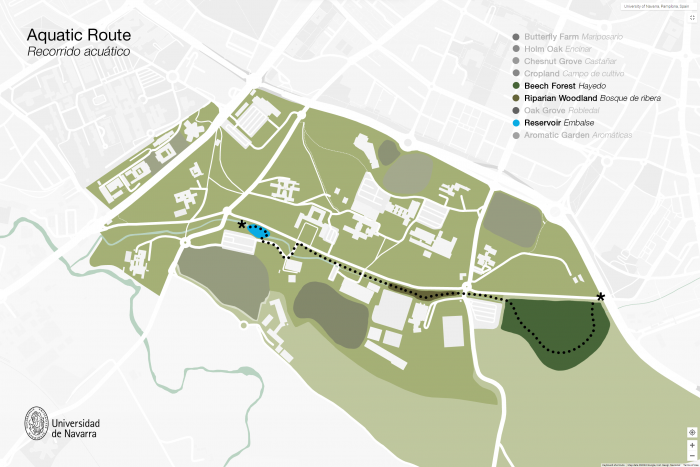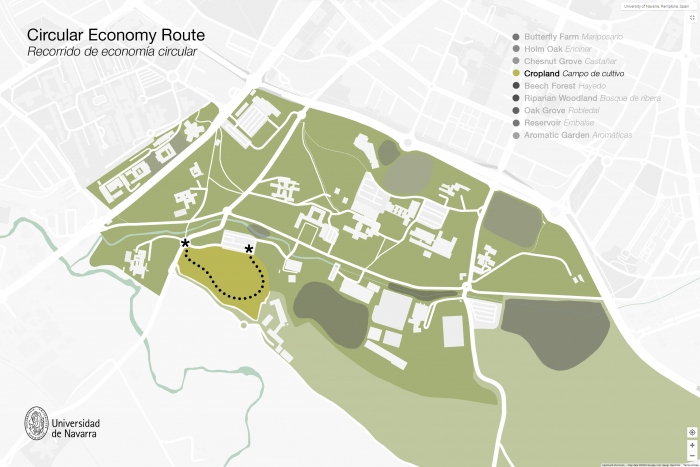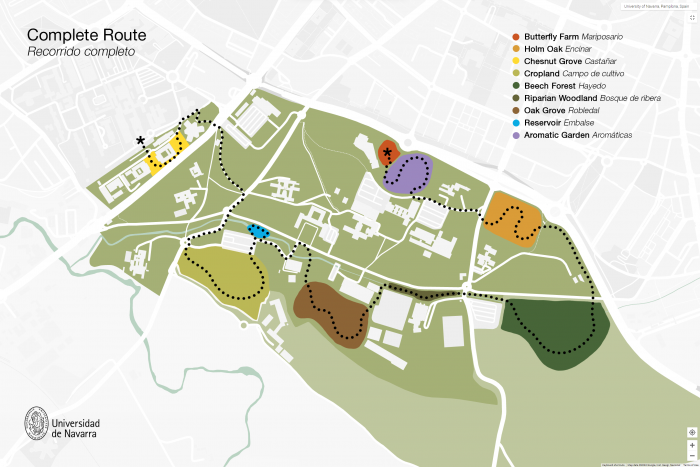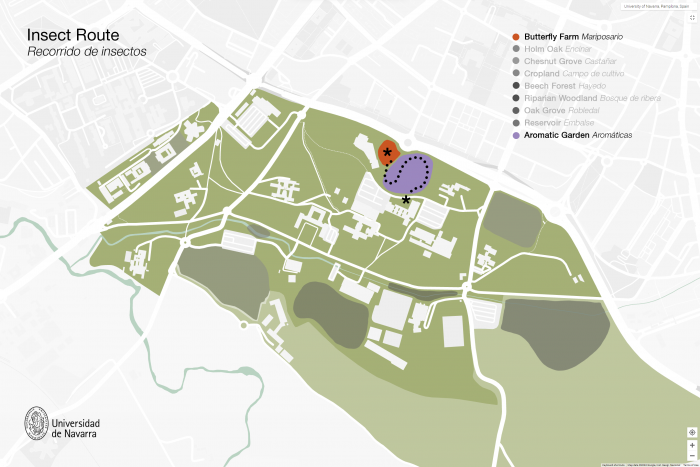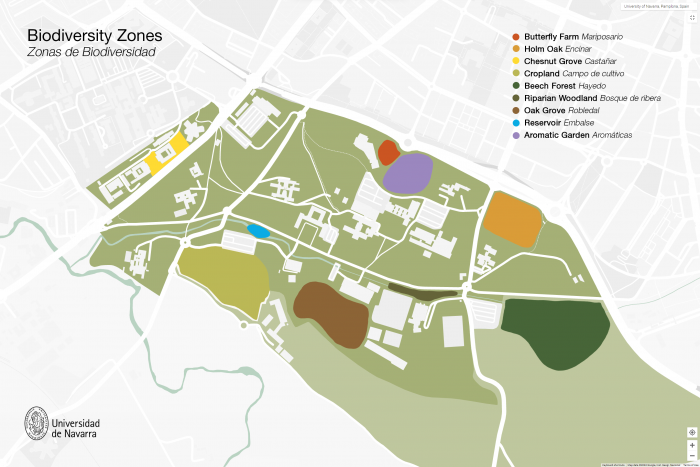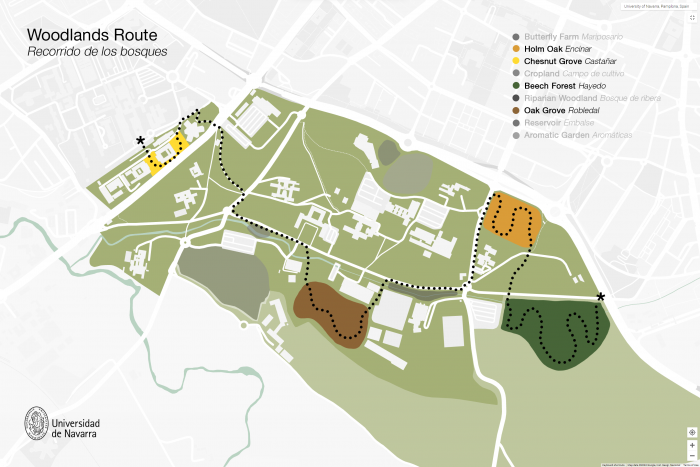The project aims to "enhance a peri-urban area" by optimizing its function for society.
Navarra, has outstanding climatic characteristics, hosting in its approximately 10,000 km2 many of the European climatic regions and their Biodiversity.
The idea is to represent, in part of the campus of Navarra University, some characteristic habitats of Navarra, and to create treks accompanied by explanations that inform the visitor of the natural/cultural values collected in them.
The work area for our project is a garden of great aesthetic value and recognition; it is the first Spanish University Campus to obtain the Green Flag Award, four times in a row. Students have the privilege of using it for a large number of training and leisure activities, but so much more could be done. For this reason, the purpose of this idea is to utilize the campus's full potential.
The idea is to use part of the 113 Ha of the campus to represent the most characteristic climatic regions of Navarra, thus reflecting the main climatic regions of Europe, and the associated biodiversity. Routes will be created with information that will explain the natural or cultural values collected in it, giving value to the traditional optimization done by mankind in the territory. To do so, we propose interdisciplinary landscape transformation actions that combine environmental knowledge and service design. These consider: 1) the characteristics of the Campus and 2) citizens demands. A gain of environmental value in the campus as well as points of social and cultural interests will be attractive for visitors and will enrich education, allowing the university to meet its objectives.
Another point of view regarding this transformation is the quality improvement that the existing areas will undergo (semi-natural, gardens, paths and meeting points, etc.). It will promote an interconnection of its parts and will allow for its diversity to further develop according to its needs. Also, an increase in the quantity and quality of urban (and peri-urban) green infrastructures, which happen to be very demanded by city inhabitants, would happen.
The objectives will be aligned with the Sustainable Development Goals of the United Nations (it has been estimated up to 10 of them), and the design of the actions, which will have different dimensions, will be supervised to comply with the standards for Solutions based on Nature designed by the International Union for Conservation of Nature.
Please highlight how the concept/idea can be exemplary in this context
In accordance with the Nature-Based Solutions Initiative, our project aims to improve the urban area of Pamplona to promote social wellbeing and health. Since pollution is largely concentrated in urban areas, it is crucial that these are well managed and integrated systems that help mitigate climate change effects, while boosting connection and education for its citizens. The fight against climate change should be approached form different scopes such as architecture, environmentalism, and production among others and we, as students, believe this to be true. Therefore, we focus on sustainability, especially in environmental education.
The objectives the project would accomplish are:
1) Represent the major ecosystems in Navarra in various points throughout the Campus;
2) Use these “scenarios” for educational and research activities.
We acnowledge the sustainability and circularity go hand by hand. For this reason we will use spaces that are already part of the campus and limit the amount of unsustainable resources in their creation. For example, the structure for the butterfly greenhouse could be made so that it doesn’t need artificial light and the available light from the sun could be used as energy for heating purposes in the house. In terms of circularity, we could use the food waste that is generated in Campus as fertilizer for the crops that are harvested. A the same time, these could be used to feed the farm animals of the campus. Finally, the energy produced from the hydroelectric production plant that is intended to be placed on the river could be used to iluminate some elements of the campus, making the process self sufficient.
Please highlight how the concept/idea can be exemplary in this context
We aim to highlight Navarra’s environmental qualities through a holistic approach, which aims to create a natural environment that connects students, professors, and other Pamplona citizens to nature. The connection promoted by the flow of our design concept has the purpose of encouraging the general public to learn, study, observe, and spend time in nature. We wish to achieve this by implementing an urban forest, a pond, a community garden, and even a butterfly greenhouse. All of this would be connected by a route through which users would recieve information about Navarran culture and the native species of the region. All of these would wake the inner ability to watch natural landscapes and feel admiration.
It is unbelievable that nowadays our lifestyle has led us to a situation where some people have never seen a tractor, a butterfly or even a sheep.
Passing through the campus would meet the need of humans to feel connected to nature in a deeper way, and to never forget that at the end of the day, all of our resources come from there. It would be interesting to try to reduce the broad way of thinking that food comes from the supermarket and energy comes from plugs.
Another twist added to this project would be the local factor, that also contributes to the attractiveness of the site. Native species such as beech trees, the common minnow and lavander, among others, would be introudced in a controlled way. This would would help to observe its intrinsic beauty and value. Moreover, we have also planned to include traditional activities done in Navarra, such as: cereal agriculture, cattle raising and renewable energy production.
Please highlight how the concept/idea can be exemplary in this context
Inclusion is the main pillar, being present from the beginning. As team that has worked in creating the project, we are a multidisciplinary and diverse, showcasing different specializations around biology, marketing, design and international relations. We represent the University of Navarra and an international setting, including Spain, Peru, Puerto Rico and the Philippines.
This project revolves around a search for equal learning opportunities and contact with nature, for all kinds of personal situations. An inclusive project is proposed that allows access to all areas of interest, giving special importance to people with reduced mobility, so that they are not limited. Specifically, it would be sought that at least none of the sections of the proposed routes would be inaccessible for people with mobility problems, through the use of bridges, walkways, railings, etc.
On the other hand, the campus is already normally visited by the general public, so this idea would give a renewed air to the environment, which would make it attractive and useful, inside and outside of the city.
In addition to the visitors, a direct effect of the execution of this idea would be the employment opportunities generated from the activities of maintenance, design, innovation, research, education, etc. For example, the educational approach would allow professionals in the scientific field to find a place on campus where they could share their knowledge on a paid basis, as well as provide researchers with a workplace and new lines of investigation, or provide a local farmer with farmland where they can carry out their daily activities.
Any type of investment that seeks to enrich the project would bring back an indirect positive effect on the population, favoring well-being and quality of life. Furthermore, in terms of affordability, the investment to be made would not be excessively large, since the land is already available, as well as the idea and an initial work team.
Please highlight how this approach can be exemplary
In terms of sustainability, quality of experience and inclusion, all of them are well reflected on the idea.
In order to achieve a high quality of the experience, everyone should be considered when it comes to enjoying spending time at the campus. None of the visitors would feel excluded from any of the activities that could be done at the place, enhancing its attractiveness. In terms of the opportunities that carrying out the project could offer, inclusion would also take place, as job opportunities would arise for professionals from different fields, such as: designers, engineers, biologists or tour guides.
Also, the future of city life must include sustainable options, so that the campus could be a thumbnail example of how certain objectives could be achieved, giving a special value to explain and practice circular economy. The sustainable activities that we have considered would be placed in the most diffused way within the landscape, making it pleasant to the eye at the same time. For example, the construction of a hydroelectric energy production mill would be carried out in a waterfall placed in the river, which also would allow the passage of aquatic animals. Moreover, the rural activities such as cattle raising or farming would be done through structures and methods that mimic those used in the region, increasing its aesthetic value.
Finally, this approach can be exemplary for its futuristic projection, to familiarize and educate the population and cause a desire to continue innovating along these lines. At the moment, Navarra does not have any garden which brings together part of the plant and animal richness contained in it. Achieving enough funds to be able to take this step would be great news for the city of Pamplona, helping it to become a reference for the region, the country or even inside Europe.
The innovative character of our proposal is founded on the development, optimization, and consolidation of existing elements found in the University of Navarra. This project aims to augment the biodiversity found in the university and increase interactions between local species, environments, and people. It is a holistic proposition anchored in seemingly unrelated fields: environmental science/ biology and service design. However, by unifying these approaches, we can arrive at a sustainable, functional, enriching, and inclusive ecosystem that highlights the natural and cultural relevance of our flora and fauna.
Concretely, our proposal is unique in its nature: its content (local species), form (cultural routes), and location (university setting). First off, the content demonstrates innovation founded on heritage by using the available 113 Ha specifically to highlight the local Navarran flora out of our 4200 trees and 130 vegetal species on campus. Next, the form or way that we want to carry out this proposal is through service design methods, graphic design, and wayfinding. We could analyze users’ existing behavior and sentiment through a customer journey map, foot traffic map, and interviews. The actual development of the routes are based on a curatorial (arts) approach to the local Navarran flora and fauna, creating routes that provoke discourse within the species themselves, their surroundings, and those who come in contact with them. To reinforce this, the relevant information can be expounded through different paraphernalia that act as distribution channels: existing student newsletters, pamphlets, posters, stands, and even a mobile application. We are not conscious of any other university that houses such a treasury of biotic components and highlights such to increase biodiversity and awareness of the university students within the ecosystem they belong to. Due to the nature of our proposal, the consequences would likely result in equally innovative outcome.
First, we would like to implement a digital tracking system so that users can register their visit and share the pictures and reviews of the route while visiting it. Then, we would like to create alliances with local schools and local cultural centers, to promote their participation in the initiative and lead to complementary activities that are able to involve even more people that do not have a direct link with the University.
In third place, we estimate that it would be very beneficial to create a network of volunteers to participate as tour guides in our route and also in order to have active seekers of collaborations with external entities that might not have knowledge of the existence of this project. Moreover, students that are associated to the environmental biology department, could be assigned some of the guiding activities or conservation actions. This would not only be benefitial for their academic trajectory but would also be a boost for their curriculum, which in instance would also profit the project itself.
Lastly, we estimate that forming alliances with local tourism organizations would be very interesting, taking into consideration the characteristics of this initiative. This would be translated into local tourist guides showcasing our project and the city’s hall promoting visitors to enjoy the route and to include it as a part of the activities that they organize in Pamplona.
First, we think it would be essential to find funding in our regional area, by asking to the sustainability office of the Government of Navarra or by promoting its touristic value to local tourism agencies. Then, we would create an alliance with the Sustainability Club of the University of Navarra in order to involve all possible students into the creation of projects that leverage our route.
We would discuss the implementation of the specific activities with experts of the different scientific departments at the university, in order to adapt our scenarios of:
- Riparian forest next to the river, including placing a little hydroelectric production plant on a waterfall.
- Beech forest with typical atlantic species.
- Oak grove with plants of humid places.
- Tropical butterfly greenhouse, as an extra place for installing some tropical species.
- Holm-oak wood, as a typically mediterranean forest.
- Chestnut forest, with a special emphasis on distinguishing between the local species: Aesculus hippocastanum and Castanea sativa.
- Pond, an aquatic ecosystem. This place could be used as an outdoor laboratory for investigation in aquatic sciences.
- Crop field with cereal species, associated with a mini-farm, where part of the production would be used in feeding the animals.
- Aromatic scrub, as a place that gathers pollinators, a living example of the importance of the interaction between both parts.
We have considered establishing the following treks: “Aquatic route”, “woodland route”, “Circular economy route” and “Insect route”, and the complete one.
All of this could be translated into research papers taking data from our biodiversity scenes or activities to connect with nature during busy days. We also suggest for it to become a monument of the city, a central point for citizens to reunite and have a great time. Finally, our idea is to form a Service Design team to analyze users’ existing behavior and sentiment to further develop said cultural routes, parapher
@Gonzalo Valmala, 2022
Content licensed to the European Union.
